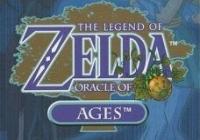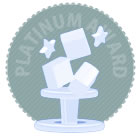The Legend of Zelda: Oracle of Ages (Game Boy Color) Review
By SirLink  04.01.2013
04.01.2013

After the sublime The Legend of Zelda: Link's Awakening, which also received a Game Boy Color remake in 1998, the torch for portable Zelda games was passed to a Capcom subsidiary called Flagship. In a very surprising move for the series, the team developed two different games that were released simultaneously and included plenty of connectivity features between the titles via passwords or Game Boy link cables. Did this decision pay off or was it a mis-step that shouldn't have been made? This review, focusing on Oracle of Ages, holds the answer…
At the beginning of the story, Link is sent from Hyrule to Labrynna where he soon witnesses the Sorceress of Shadows, Veran, possess the Oracle of Ages, Nayru. Having full control over her, she uses Nayru's powers to her advantage and travels through time to bring untold sorrow to the world. Link then meets Labrynna's guardian, the Maku Tree. He finds out that the eight Essences of Time are the only way to defeat Veran. However, they are scattered throughout time and it would be impossible for one person to find all of them. Luckily, Link soon acquires the Harp of Ages that allows him to traverse time and look for all the Essences of Time while correcting any damage Veran has caused to the land of Labrynna.
The gameplay is very similar to Link's Awakening in terms of controls. Link is moved with the D-pad and both the A and B button can be used to equip one weapon or item at a time. Much like other games in the series, the goal is to explore the world and discover various dungeons to complete. Labrynna is smaller than Holodrum of Oracle of Seasons and its subterranean world of Subrosia but the fact that there are two time periods with often completely different looking areas makes up for it.

While time travel was already present in The Legend of Zelda: Ocarina of Time and The Legend of Zelda: Majora's Mask, its potential wasn't fully utilised in either of them. This game takes the idea of time travel and makes it a major gameplay element, providing many puzzles around the concept. The item that makes all this possible is the Harp of Ages, with its ability to warp the user between the present and the past. However, at the beginning Link can only play the Tune of Echoes that activates time portals that take him to the opposite age. A bit further into the game the Tune of Currents becomes available that, when played in the past age, instantly creates a new portal to the present. Finally, the Tune of Ages unlocks the full power of the Harp of Ages and grants it the ability to freely travel to the opposite age. There are some limitations to ensure that players won't break the game, though. If the location that's warped from is inaccessible in the other time period, then it will automatically transport Link back. The Harp of Ages also can't be used in dungeons but that doesn't mean the game isn't taking full advantage of the mechanic for some tricky puzzles. While most are on the overworld and have to be figured out to reach the next destination, one particularly infamous dungeon requires to be explored in both ages and it's certainly not easy to figure out how to get through it. The two time periods also have different colour palettes, with the present looking bright and colourful while the past looks appropriately bleak.
Link also teams up with three animal partners along the way but only one of them can be a permanent companion, based on the flute that is obtained. The first one is called Ricky, a boxing kangaroo that carries Link in his pouch, can use his fists to kill enemies, scale large walls and jump over small pits. Then there's Dimitri, a friendly red Dodongo that can bite and eat enemies as well as swim up waterfalls and through tough currents without being pulled along. Last, but not least, is Moosh, a large blue bear with wings. While Ricky can only jump over one hole at a time, Moosh can hover for a short period of time to get past long strings of pits in the ground and attack enemies with a ground pound. Depending on which partner is chosen in the end, the terrain of some areas in Labrynna will actually change to adjust to the specific abilities of the chosen animal.

It's not immediately noticeable, but Oracle of Seasons and Oracle of Ages focus on one particular element that defines the gameplay of the Zelda series. Seasons has a lot more action, such as combat and generally tests the player's skill a lot more. Ages, on the other hand, is very puzzle-based and challenges the mind with some extremely tricky puzzles. That's not to say that they are completely lacking in the opposite area, though. The selection of items available also varies slightly, with some being exclusive to one game. For example, Oracle of Seasons has a Magnetic Glove that pulls Link toward or pushes him away from magnetic objects. Oracle of Ages contains an item called the Switch Hook. Unlike the classic Hookshot, Link will switch places with whatever it grabs when he fires it. In true Zelda fashion, both are used in some very clever ways to solve puzzles or even defeat enemies. Decisions like these makes both entries feel distinct while still sharing a lot of other elements.
Another very refreshing and addictive feature that's only found in the Oracle series is the inclusion of rings. These useful items can be obtained in a ton of different ways and can be equipped to gain special abilities. The effects can be incredibly varied, from simple attack or defence boosts to transformations that are purely for cosmetic purposes or even modifications to Link's basic abilities and items. For example, with the right ring, a bomb will not explode while it's still being held. There are even ones with negative effects to make the game more challenging for particularly brave adventurers. A total of 64 rings can be collected throughout both games but they can't be used right away. A found ring is unusable until it's appraised by a jeweller called Vasu. Once that is done, it will be added to the collection at his shop. To actually use a ring, it has to be put in Link's ring box and equipped from there. The ring box only holds one at first but can be upgraded via side-quests to be able to carry more without having to go back to Vasu's shop each time to switch them out. This system is very well made and gives an almost RPG-like twist to the games, yet another element that makes the Oracle series stand out from many other entries in the Zelda franchise.

The addition of connectivity between the two games was very ambitious for its time and the system they were released on, even surpassing what the Pokémon series offered at the time. At the end of either game, a secret password is shown that can be used on the opposite title to start a 'Linked Game' that changes part of the main plot and grants access to the true ending and story while also creating many small events that would otherwise not happen. On top of all that, an optional dungeon becomes accessible in both games. While they share the same name, both are very different and very difficult to complete. There are many other cool and useful secrets to be discovered in the Oracle series, so this is just scratching the surface of what this connectivity system offers. It should also be mentioned that they were released at the end of the Game Boy Color's lifespan and actually have some extra content for the successor, such as a secret shop that can only be accessed when played on a Game Boy Advance.

Cubed3 Rating
Masterpiece - Platinum Award

The Legend of Zelda: Oracle of Ages is an absolutely outstanding game. Along with Oracle of Seasons, it's one of the best games the Game Boy Color library has to offer and can easily compete with Flagship's later efforts, like The Legend of Zelda: The Minish Cap on the Game Boy Advance. Unfortunately, Flagship ceased to exist in 2007 and its employees merged into Capcom's main studio, so it's very unlikely that another handheld Zelda game from them will ever be made again. What should definitely be seen, though, is both this game and Oracle of Seasons being released on the 3DS Virtual Console, following the release of Link's Awakening DX shortly after the 3DS launched.

![]() 10/10
10/10
![]() 10/10
(31 Votes)
10/10
(31 Votes)
 Out now
Out now  Out now
Out now  Out now
Out now  Out now
Out now Comments
Comments are currently disabled

 Sign In
Sign In Game Details
Game Details Subscribe to this topic
Subscribe to this topic Features
Features







 Top
Top

